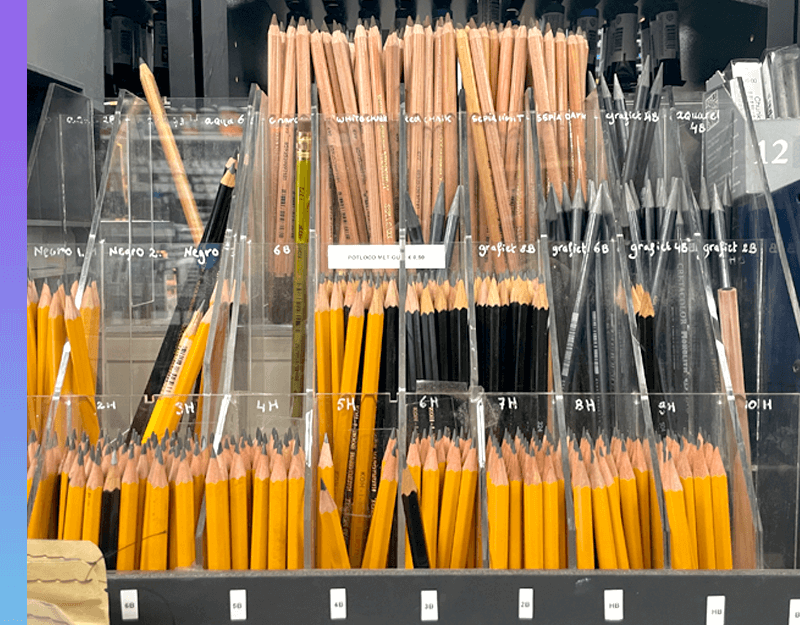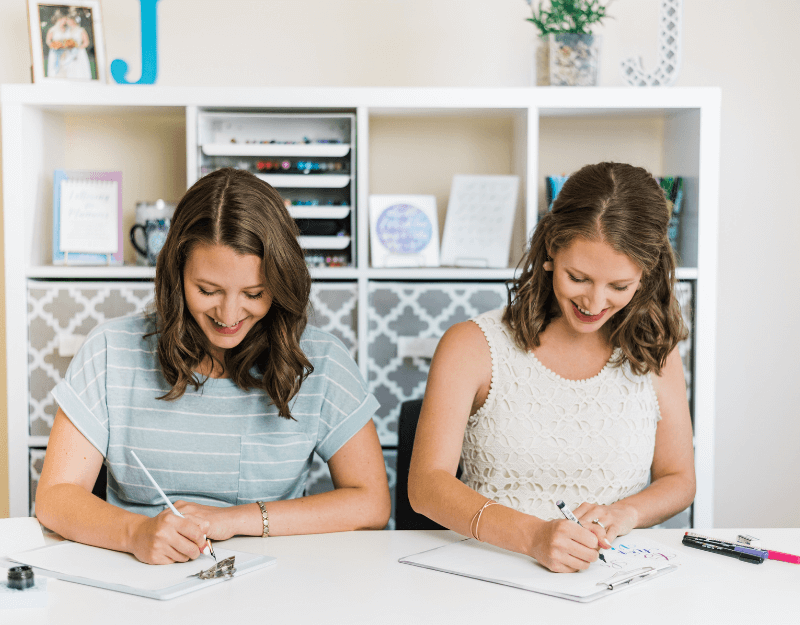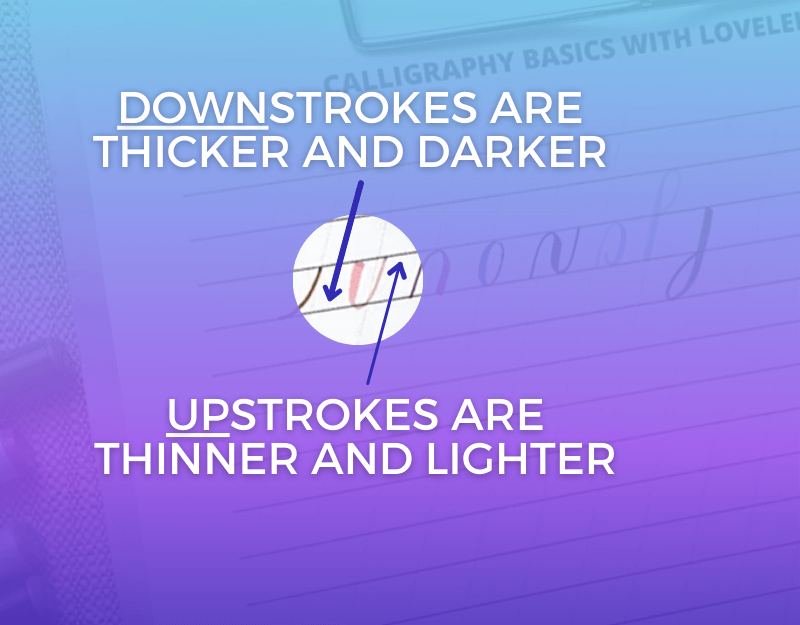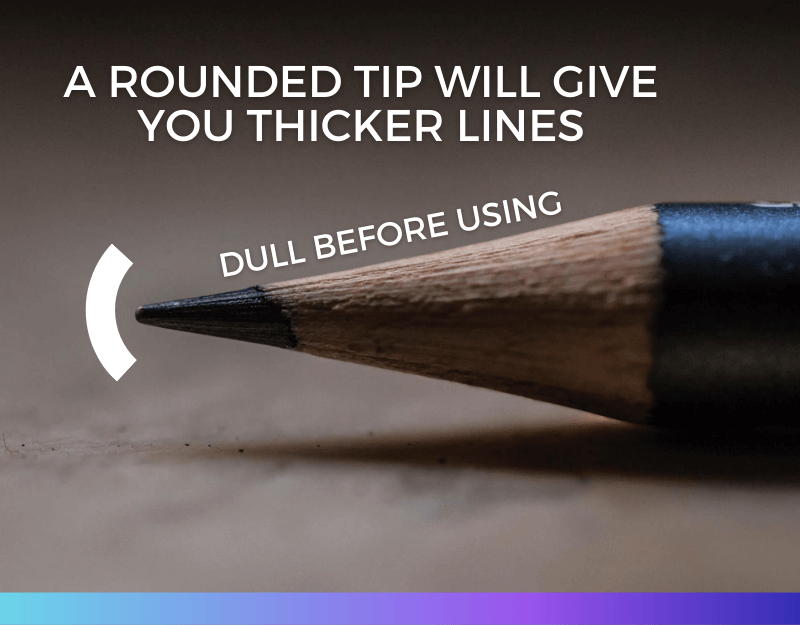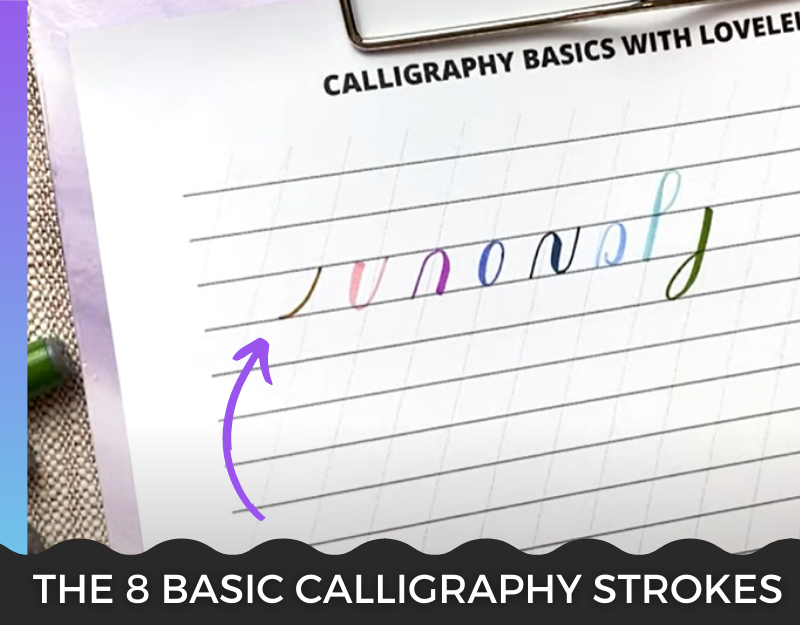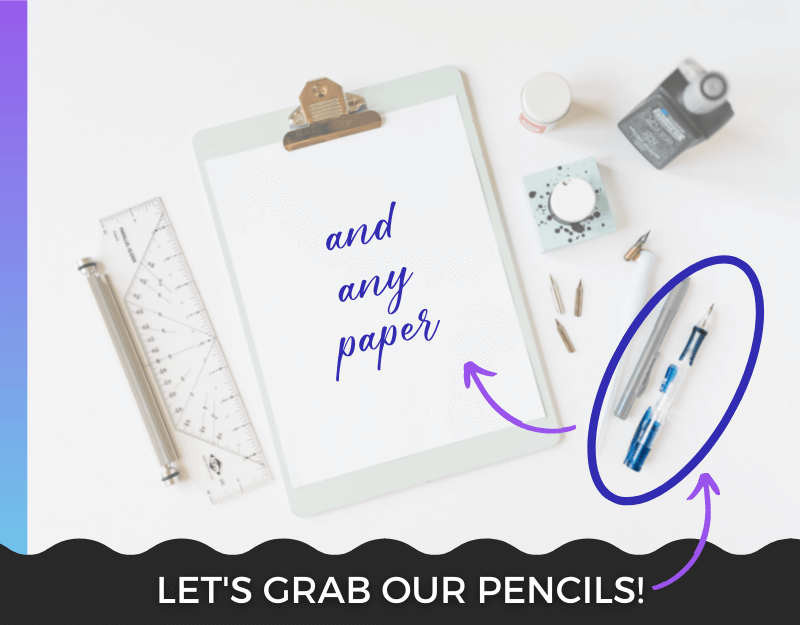Pencil Calligraphy For Beginners: FAQs, Prompts & Worksheet
We could talk about brush pens, steel nibs and ink all day (and sometimes we do!) but there’s still something special about simple pencil calligraphy. It might not be shiny and colorful, but it has a valid place in the calligraphy world, as much as its more traditional counterparts.
Let’s talk about when to reach for a pencil over a pen, what you need to practice, and go over all of your other FAQs around pencil calligraphy for beginners.
Table of Contents
Don’t forget to pin it so you can find and reference later! ↓
What Is Pencil Calligraphy?
Pencil calligraphy is the humble act of practicing calligraphy with a pencil instead of the more traditional medium of ink. It’s a very versatile and accessible form of calligraphy, not requiring specific or pricey tools.
Prefer to watch instead of read? We also have a video explaining pencil calligraphy! ↓
What Type Of Pencil Do You Need For Pencil Calligraphy?
There’s no single “calligraphy pencil” that’s required to enjoy this type of practice. You can use the common pencils that you have around your home, such as the popular Number 2 “lead” pencil, or even mechanical pencils.
Any average pencil around your home will do, but it’s still fun to browse through the options at your local art store!
Fun fact: lead pencils don’t contain any lead and never have! And thank goodness for that.
Standard pencils are filled with graphite, but they’re incorrectly known as lead pencils. An incorrect association with a writing tool dating back to Roman times is to blame for this slander (lead is poisonous, after all).
During Roman times, the stylus was the preferred tool for writing. The stylus was made of lead and could do more than just writing. At a particularly heated debate in the senate, Julius Caesar is said to have stabbed a fellow senator in the arm with a stylus! Maybe he needed a relaxing hobby like calligraphy to help him manage his stress. 😁
We’re so glad you’re here to learn calligraphy with us!
These days, “lead” pencils are filled with graphite, a chemical substance that has the lovely quality of leaving a mark across the page that gets darker with increased pressure. This characteristic makes it perfect for practicing calligraphy.
The pencils we use today are luxury items compared to the original ideation. The original pencils discolored the hands of scribes since they lacked the wooden casing around the outside. After experiments with wrapping the graphite core with string or twigs, the wood cased pencil was discovered and this was the birth of the basic pencil we still use today.
You may also like: The History Of Calligraphy
How wonderful it is to be calligraphy lovers at a time when our writing utensils are safe, affordable and easy to find!
Any type of modern pencil is suitable for pencil calligraphy, but there are different pros and cons to certain types. Why don’t you grab a pencil that you already have in your home now and let’s look at it together (*reaches for giant cart of drawing utensils*).
Pencils Variations, Pros And Cons
If you pick up your pencil, you should see some identification on the end opposing the writing tip:
Numbers refer to the different levels of graphite, and the letters refer to the hardness:
These are the common identifications on pencils:
H which stands for “hard”
B which stands for “black”
HB which stands for “hard black”
F which stands for “firm”
The most common household pencils are no. 2 pencils, which are labeled HB. These pencils became the gold standard for academic use because number 1 pencils smudged too much and number 3 pencils were stiff and broke too easily. They sit comfortably in the middle of the spectrum.
Each type of pencil comes with a specific level of hardness. The harder the graphite, the lighter your pencil writes, as you can see on this pencil display at the local arts store:
Generally an HB (your standard no. 2 pencil) works well. If you have a variety of pencil types at your disposal, choose softer as it allows for more contrast.
You may also like: World Calligraphy Day Guide
Likewise, a pencil with thicker graphite also works better than thinner graphite. This gives you thicker downstrokes and has a wider range:
To get as much surface area as possible, your pencil shouldn’t be recently sharpened. A soft, rounded tip makes drawing thicker lines easier and creates more contrast between your downstrokes and upstrokes.
Photo by Francesco Lo Giudice on Unsplash
You may also like: Favorite Calligraphy Supplies
Usually there’s nothing more satisfying than a freshly sharpened pencil! But for this occasion, reach for one with a dull tip instead when you practice your pencil calligraphy.
That’s a lot of details about the everyday household pencil! Here’s your checklist:
Find any pencil that you have
Choose the thickest one that you have
A dull tip is better than a recently sharpened pencil
The softer the graphite the better (look for “B” instead of “H”)
With your pencil in hand, you only need one more piece of equipment: paper.
You may also like: How To Write “Thank You” In Calligraphy
What Type Of Paper Do You Need For Pencil Calligraphy?
This answer is much shorter for you: any paper will do! Even pieces of scrap paper, margins of mail or post-it notes!
We made you a practice calligraphy sheet that’s perfect as a printable pencil calligraphy worksheet to practice on.
These calligraphy worksheets are perfect for when you have a little more time to structure your practice. We have dozens of free calligraphy worksheets for you - look around our calligraphy worksheet vault.
When To Use Pencil Calligraphy
Pencil calligraphy is the perfect medium for beginners to work on their basic strokes, flourishes, or any new designs. Mastering calligraphy takes time and the only way to improve is instruction and practice.
You build up your skill through repetition, and the repetitions add up. Why waste precious ink and paper on something as simple as daily practicing? Unless you’re looking for an excuse to buy more ink, in which case we totally understand.
When you’re in the process of mapping out a design for a quote or a card, a pencil is your friend because it comes with an eraser. There isn’t the same pressure to get it right the first time as there is with ink.
Pencil calligraphy is also the perfect type of calligraphy for kids. It’s not messy, permanent or expensive. Why not practice your pencil calligraphy with one of the little ones in your life?
Whether you’re practicing traditional calligraphy or modern calligraphy is more your style, using a pencil to practice will save you ink and help you boldly explore new designs without the pressure of perfectionism.
What Can A Pencil Do When It Comes To Calligraphy?
Pencils are a flexible tool that can be used for different styles, from hand lettering to calligraphy and anything in between. Just like with a nib, you can apply pressure on a pencil to create those lush downward strokes.
The easiest way to get started with pencil calligraphy is to practice faux calligraphy. Faux, or false calligraphy, is the practice of using the fundamental strokes to build your letters and then going back to color in the areas with shading. In other words, you apply the contrast between up and downstrokes after you’ve written your word.
This process, illustrating letters rather than focusing on beautiful writing, is where a pencil can truly shine. You can try out different styles such as hand lettering, 3D-lettering or even broad edged calligraphy where you use two pencils at once! Watch our tutorial to see how.
Finally, a pencil can be used to practice true calligraphy. Using a soft pencil is perfect for working on your copperplate script. Build letters with the fundamental strokes while applying extra pressure on the downward strokes to create a beautiful contrast between heavy and light lines.
You may also like: How To Do Calligraphy With A Normal Pen
How to write calligraphy with a pencil
The fundamentals of calligraphy are the same: no matter what tool you’re using, you create letters and words using a combination of the 8 basic calligraphy strokes.
Remember that the big difference between pencil and pen calligraphy is the use of pressure. Practice the individual basic strokes, applying pressure as you make downward strokes and light upstrokes.
Practice slowly: no rush, just having fun and focusing on contrast between up and downstrokes as you make individual basic calligraphy strokes.
It’s important to really ingrain the fundamental strokes when practicing pencil calligraphy. The lowercase letter ‘g’ alone consists of four basic strokes! There’s no award for rushing through them in practice; you’ll be relying on them to keep your letters together.
Once you have confidence with the basic strokes, try the whole lowercase alphabet.
Download our practice sheet to help guide you through your practice sessions. And don’t forget to have fun!
Pencil Calligraphy Prompt
We can encourage you to practice the basics all day, but we know you’re chomping at the bit to try more. Here are 5 prompts for practicing pencil calligraphy:
Try the entire lowercase and uppercase alphabet.
Practice writing your whole name.
Practice writing someone else’s name and give it to them when you’re done.
Write a favorite song lyric or quote.
Practice writing the entire date, then tape it into your journal or planner when you’re done!
Ready for even more ideas? Here are more calligraphy prompts that you can try right now!
Final Thoughts
Calligraphy can be thought of as an expensive hobby, but that doesn’t have to be the case. We love fancy dip pens as much as anyone, but there’s merit and fun in basic pencil or pen calligraphy using the tools around your home right now.
Don’t forget to download our practice pencil calligraphy worksheet to help you master the basic strokes.
If you find yourself having a blast with these pencil calligraphy worksheets, and want to dig deeper into the whole spectrum of calligraphy, be sure to check out our comprehensive course + community: Loveleigh University. We open doors for enrollment twice a year and would love to welcome you into our next group of students!
Pssst…if you don’t want to wait, you can buy individual calligraphy courses right away for pen and paper calligraphy or iPad lettering (or both!)
As always, we’re so glad that you’re here learning calligraphy with us. We love being your calligraphy teachers.


